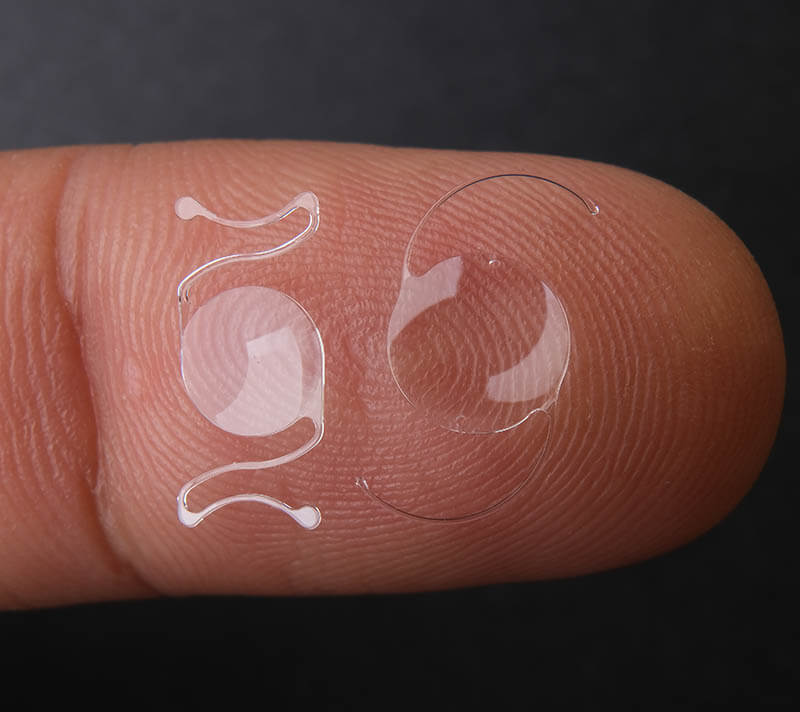Home » Services » Cataracts
Cataract Surgery
Are you ready to see clearly?
Welcome to the cataract surgery center of Slade & Baker Vision Center. If you suffer from cataracts or have lost the ability to see up close, you have come to the right practice.
Dr. Slade is a pioneer in the field of refractive cataract surgery. Our patients not only have the choice to see at all distances after surgery, but they were also the first patients in the United States that could have laser cataract surgery.
Cataract Surgery
Surgery to remove cataracts is one of the most frequently performed procedures today. It is also one of the most successful and safest procedures in medicine today. It is estimated that there are over 14 million lens implant procedures performed each year.
Cataract surgery is elective surgery and that is good news for the patient. There is no need to wait until your vision is very poor. We advise our patients to consider cataract surgery when the cataract begins to affect their lifestyles; close vision, driving, sports, reading, or otherwise. The cataract will typically not damage your eye while it is growing, so there is also no need to rush into the surgery. You can decide when the time is right for you!
Dr. Stephen Slade performs the procedure within our office based operating suite or at our local surgery center, just a few blocks away from our offices. You will arrive about an hour before your actual surgery. You will be given a mild sedative to help you relax. The area around your eye will be cleansed and a sterile drape will be applied around your eye. The surgery only takes a few minutes but plan to spend 2 to 3 hours at the center for the pre-operation procedures and recovery.
Dr. Slade will use a powerful anesthetic eye drop to completely numb the eye. Using only a topical anesthetic avoids the risks and pain associate with needle injections and provides a much quicker return of vision. There is no need for shots or injections.
A small instrument will be placed between your eyelids to keep you from blinking. In Laser Cataract Surgery, the laser is used to make the opening in the eye, an opening in the lens itself, and to treat the lens. If needed, an ultrasonic instrument will then gently break the cataract into microscopic particles, which are then suctioned away.
Cataract Symptom Checker
Intraocular Lenses or IOLs
Next, the Intraocular Lens (IOL) you chose to correct your vision will be inserted into the same location that your natural lens occupied. Once the IOL is locked into position, the micro-incision seals itself, typically without the need for sutures. It remains tightly closed by the outward pressure within the eye and provides a fast, much more comfortable recovery.
You will be released soon after the procedure to go home and relax for the rest of the day. Your eye will not be patched and most patients are able to see well after surgery.
Visual recovery varies from patient to patient but most patients return to their normal activities within a day or two. If you have cataracts in both eyes, the second procedure will usually be scheduled within a week or two.
Serious complications are extremely rare, but it is surgery and there are some risks involved. One of our counselors will provide you with additional information about the risks associated with cataract surgery. Choosing an experienced surgeon for your procedure can significantly minimize the risks involved with your cataract procedure. To learn more about which IOL is right for you, take our free IOL Self-Test!
What to Expect After Cataract Surgery
Most patients are concerned about the cataract surgery recovery process. Our doctors provide the best quality care and thoroughly explain what you can expect after cataract surgery. Recovery from cataract surgery is generally very quick. Most patients obtain better vision within the first 24 hours of the procedure. Itching and mild discomfort are normal after cataract surgery. Some fluid discharge is also common. Your eye may be sensitive to light and touch.
If you have discomfort, your doctor can suggest treatment. After one or two days, any moderate discomfort should disappear. Complete visual recovery varies from patient to patient but most patients return to their everyday activities within a day or two. If you have cataracts in both eyes, the second procedure will most likely be scheduled within a week or two. Your doctor will schedule exams to check on your progress. Each person heals differently so it is important to discuss the cataract surgery recovery with your eye doctor.
For a few days after surgery, your doctor may ask you to use eye drops to help to heal and decrease the risk of infection. Ask your cataract eye doctor about how to use your eye drops, how often to use them, and what effects they can have. You will need to wear an eye shield or eyeglasses to help protect your eye. Avoid rubbing or pressing on your eye.
Serious complications are extremely rare but because it is a form of surgery, there are some potential risks involved. Our staff and cataract surgeons will provide you with additional information about the risks associated with cataract surgery and answer any of the questions you may have. If you are at the beginning of your Houston cataract surgery research project please feel free to contact us at any time.
Frequently Asked Cataract Questions
Laser Cataract Surgery
Laser cataract surgery was first performed in the United States by Dr. Stephen Slade within our office surgical suite. Laser cataract surgery uses the femtosecond laser to do many of the steps currently performed by hand and is designed to provide a greater level of precision and safety to modern cataract surgery.
“I have been involved in many new technology introductions, and I know from these past experiences that Laser Cataract Surgery, will be widely accepted by surgeons and demanded by patients all over the world,” said Dr. Slade after the procedure. “This is the cataract surgery that I would want for my friends, my family, and myself.”
Dr. Stephen Slade M.D., who performed the first bladeless laser cataract surgery in the US, performed LIVE laser cataract surgery at the ASCRS meeting in 2011. The laser is now approved in the US. Laser cataract surgery uses a Femtosecond laser to do many of the steps that have been done in the past by hand in cataract surgery. The use of the laser may add safety and precision to cataract surgery.
Cataract Surgery Benefits
Cataract surgery provides substantial improvements for those with cataracts by replacing the clouded lens with a clear artificial one. This intervention leads to a restoration of sharper and more vivid vision, enhancing overall visual clarity. Specific benefits of this procedure include:
- Restoration of clearer vision: Replacing the cloudy lens results in sharper and more vibrant sight.
- Reduction in glare: Many patients experience less trouble with bright lights, especially at night.
- Correction of other vision problems: Certain types of cataract surgery can also correct nearsightedness, farsightedness, and astigmatism.
- Potential reduction in dependence on glasses or contacts: Due to the correction of refractive errors, some individuals may need glasses or contacts less often.
Ultimately, cataract surgery aims to significantly improve the quality of life by making daily activities easier through enhanced visual function.
Monofocal IOLs
Monofocal lens implants work when light enters the actual lens and it is bent to a specific focal point. As the power of the monofocal lens becomes stronger, its ability to bend light more sharply is increased. Because the lens is monofocal, the light can only be bent to one focus point at a time. The light from these lenses is bent to focus specifically on the retina of the eye.
New lens implants are now available that can correct vision at near, intermediate and far distances. These types of lenses are commonly called “lifestyle lens implants” or premium lens implants and fall into the categories listed below. Multifocal, toric, and accommodating lens implants are all considered premium lens implants.
Toric IOL – AcrySof® Toric
If you are seeking a Houston cataract surgery expert and have astigmatism please feel free to consult the doctors at Slade & Baker Vision Center. There are NEW options available for patients that have astigmatism and need an IOL for after cataract removal.
The AcrySof® Toric IOLs are artificial lenses that are ideal for individuals who have cataracts and also suffer from astigmatism. This lens is manufactured by Alcon Technologies a widely known and respected producer of intraocular implants. Please feel free to review images of the lens and watch a video related to the procedure and the patients who have tried this lens.
You may be familiar with the term TORIC if you have ever used astigmatic correcting contact lenses. Toric Lens Implants are a unique type of lens implant that is used to correct astigmatism.
A toric lens implant is NOT the only method of astigmatism correction so consult a doctor about the current possibilities. The asymmetric steepening of the cornea or natural lens causes light to be focused unevenly, which is the main optical problem in astigmatism. To individuals with uncorrected astigmatism, images may look blurry or shadowed.
Astigmatism can accompany any form of refractive error and is very common. Astigmatism can be corrected with glasses, contact lenses, corneal relaxing incisions, laser vision correction, and special implant lenses.
If a cataract patient has astigmatism and has aspirations to be glasses-free after surgery a Toric lens implant is a good option. Toric lens implants are NOT a correction option for presbyopia. The ACRYSOF® Toric lens implant is a popular choice for this type of lens.
Astigmatism is caused by an irregularly shaped cornea, or in the case of lenticular astigmatism, an irregularly shaped lens, that results in blurred vision. Since the Toric IOL is convex on both sides, it allows for the correction of both these types of astigmatism.
Before the Toric IOL, cataract patients with astigmatism would often undergo another procedure, called astigmatic keratotomy (AK), which involved creating incisions in the cornea to adjust the corneal shape.
The doctors at Slade & Baker Vision Center understand how frustrating it can be to live with astigmatism and we hope we can offer a viable solution in a premium lens implant that is used during the cataract surgery procedure.
If you have questions, please do not ever hesitate to call our office at 713-626-5544 and speak to our experts and schedule a consultation today!
















